key CADILLAC XLR 2005 1.G Manual PDF
[x] Cancel search | Manufacturer: CADILLAC, Model Year: 2005, Model line: XLR, Model: CADILLAC XLR 2005 1.GPages: 438, PDF Size: 3.69 MB
Page 344 of 438
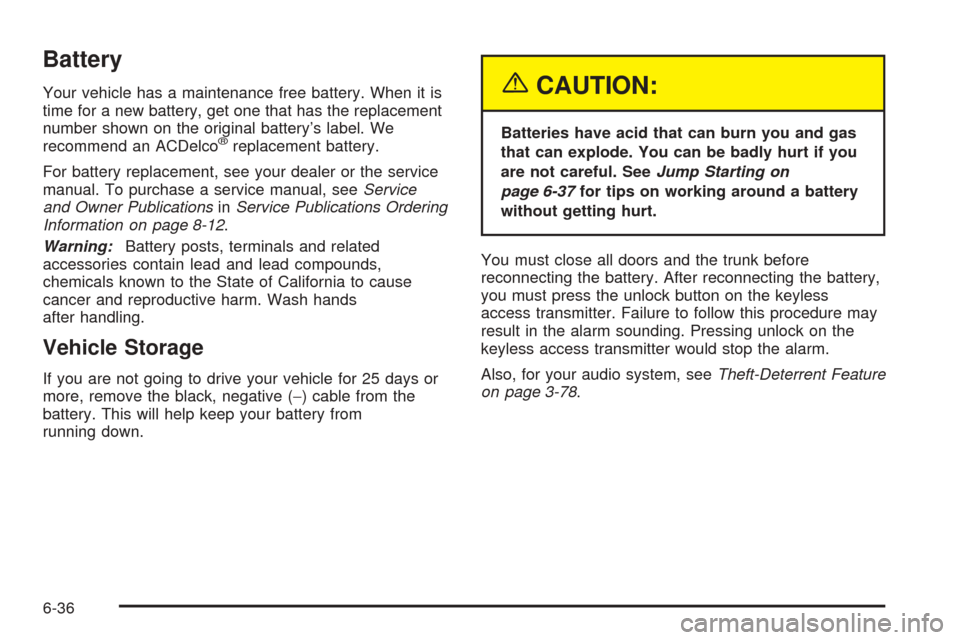
Battery
Your vehicle has a maintenance free battery. When it is
time for a new battery, get one that has the replacement
number shown on the original battery’s label. We
recommend an ACDelco
®replacement battery.
For battery replacement, see your dealer or the service
manual. To purchase a service manual, seeService
and Owner PublicationsinService Publications Ordering
Information on page 8-12.
Warning:Battery posts, terminals and related
accessories contain lead and lead compounds,
chemicals known to the State of California to cause
cancer and reproductive harm. Wash hands
after handling.
Vehicle Storage
If you are not going to drive your vehicle for 25 days or
more, remove the black, negative (−) cable from the
battery. This will help keep your battery from
running down.
{CAUTION:
Batteries have acid that can burn you and gas
that can explode. You can be badly hurt if you
are not careful. SeeJump Starting on
page 6-37for tips on working around a battery
without getting hurt.
You must close all doors and the trunk before
reconnecting the battery. After reconnecting the battery,
you must press the unlock button on the keyless
access transmitter. Failure to follow this procedure may
result in the alarm sounding. Pressing unlock on the
keyless access transmitter would stop the alarm.
Also, for your audio system, seeTheft-Deterrent Feature
on page 3-78.
6-36
Page 401 of 438
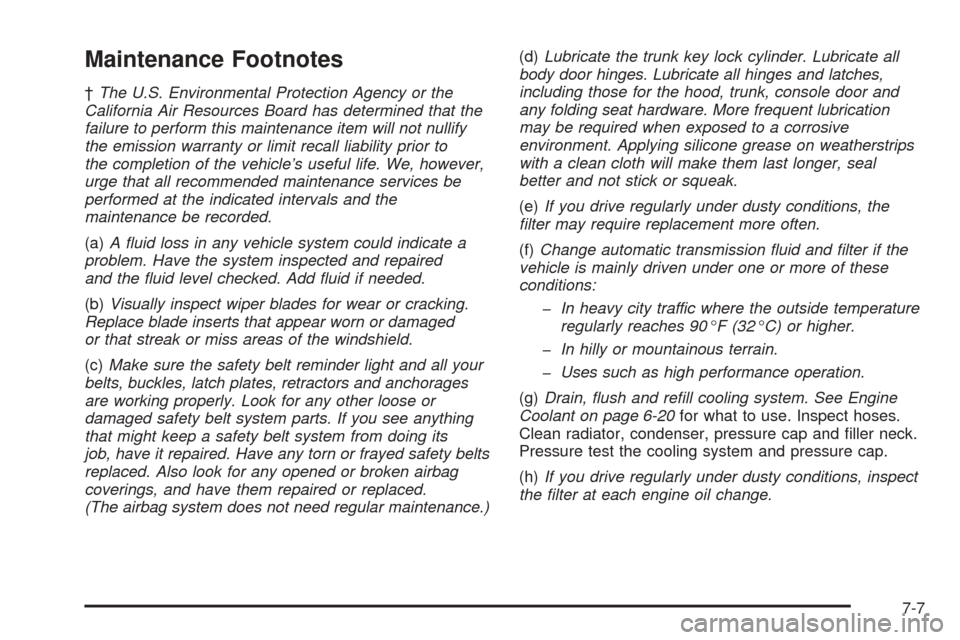
Maintenance Footnotes
†The U.S. Environmental Protection Agency or the
California Air Resources Board has determined that the
failure to perform this maintenance item will not nullify
the emission warranty or limit recall liability prior to
the completion of the vehicle’s useful life. We, however,
urge that all recommended maintenance services be
performed at the indicated intervals and the
maintenance be recorded.
(a)A �uid loss in any vehicle system could indicate a
problem. Have the system inspected and repaired
and the �uid level checked. Add �uid if needed.
(b)Visually inspect wiper blades for wear or cracking.
Replace blade inserts that appear worn or damaged
or that streak or miss areas of the windshield.
(c)Make sure the safety belt reminder light and all your
belts, buckles, latch plates, retractors and anchorages
are working properly. Look for any other loose or
damaged safety belt system parts. If you see anything
that might keep a safety belt system from doing its
job, have it repaired. Have any torn or frayed safety belts
replaced. Also look for any opened or broken airbag
coverings, and have them repaired or replaced.
(The airbag system does not need regular maintenance.)(d)Lubricate the trunk key lock cylinder. Lubricate all
body door hinges. Lubricate all hinges and latches,
including those for the hood, trunk, console door and
any folding seat hardware. More frequent lubrication
may be required when exposed to a corrosive
environment. Applying silicone grease on weatherstrips
with a clean cloth will make them last longer, seal
better and not stick or squeak.
(e)If you drive regularly under dusty conditions, the
�lter may require replacement more often.
(f)Change automatic transmission �uid and �lter if the
vehicle is mainly driven under one or more of these
conditions:
�In heavy city traffic where the outside temperature
regularly reaches 90°F (32°C) or higher.
�In hilly or mountainous terrain.
�Uses such as high performance operation.
(g)Drain, �ush and re�ll cooling system. See Engine
Coolant on page 6-20for what to use. Inspect hoses.
Clean radiator, condenser, pressure cap and �ller neck.
Pressure test the cooling system and pressure cap.
(h)If you drive regularly under dusty conditions, inspect
the �lter at each engine oil change.
7-7
Page 405 of 438
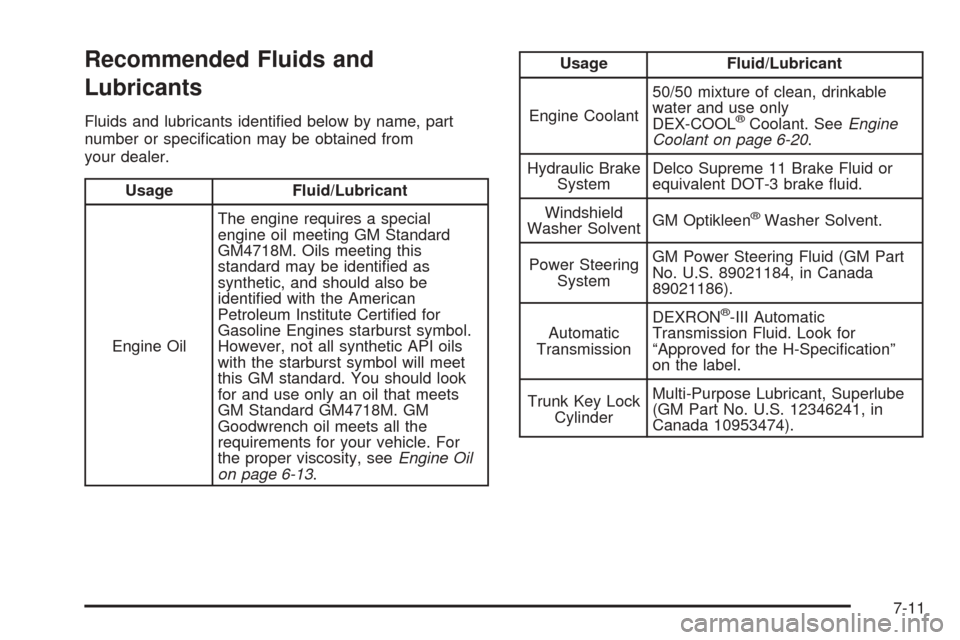
Recommended Fluids and
Lubricants
Fluids and lubricants identi�ed below by name, part
number or speci�cation may be obtained from
your dealer.
Usage Fluid/Lubricant
Engine OilThe engine requires a special
engine oil meeting GM Standard
GM4718M. Oils meeting this
standard may be identi�ed as
synthetic, and should also be
identi�ed with the American
Petroleum Institute Certi�ed for
Gasoline Engines starburst symbol.
However, not all synthetic API oils
with the starburst symbol will meet
this GM standard. You should look
for and use only an oil that meets
GM Standard GM4718M. GM
Goodwrench oil meets all the
requirements for your vehicle. For
the proper viscosity, seeEngine Oil
on page 6-13.
Usage Fluid/Lubricant
Engine Coolant50/50 mixture of clean, drinkable
water and use only
DEX-COOL
®Coolant. SeeEngine
Coolant on page 6-20.
Hydraulic Brake
SystemDelco Supreme 11 Brake Fluid or
equivalent DOT-3 brake �uid.
Windshield
Washer SolventGM Optikleen
®Washer Solvent.
Power Steering
SystemGM Power Steering Fluid (GM Part
No. U.S. 89021184, in Canada
89021186).
Automatic
TransmissionDEXRON
®-III Automatic
Transmission Fluid. Look for
“Approved for the H-Speci�cation”
on the label.
Trunk Key Lock
CylinderMulti-Purpose Lubricant, Superlube
(GM Part No. U.S. 12346241, in
Canada 10953474).
7-11
Page 430 of 438
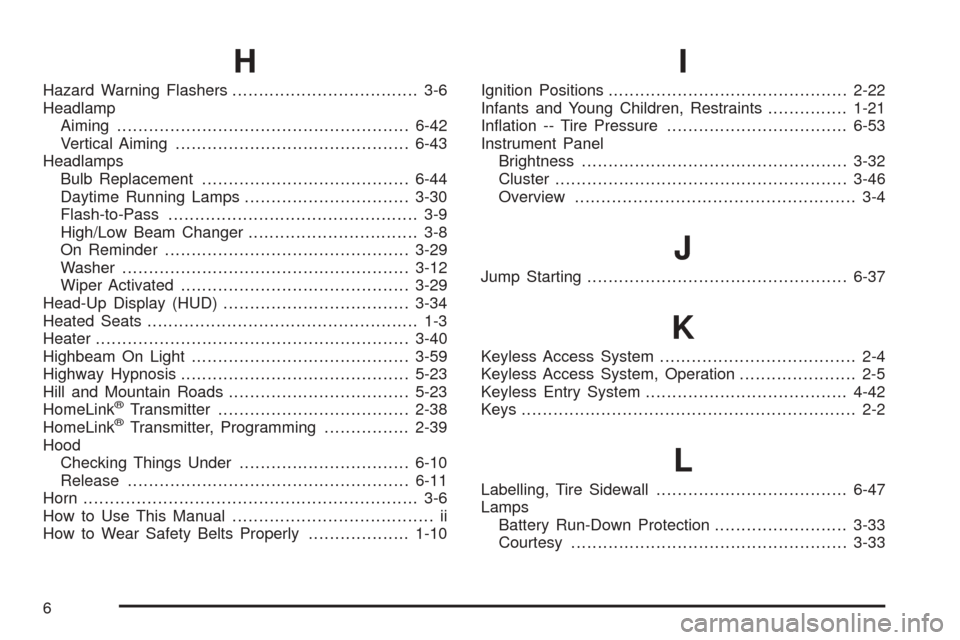
H
Hazard Warning Flashers................................... 3-6
Headlamp
Aiming.......................................................6-42
Vertical Aiming............................................6-43
Headlamps
Bulb Replacement.......................................6-44
Daytime Running Lamps...............................3-30
Flash-to-Pass............................................... 3-9
High/Low Beam Changer................................ 3-8
On Reminder..............................................3-29
Washer......................................................3-12
Wiper Activated...........................................3-29
Head-Up Display (HUD)...................................3-34
Heated Seats................................................... 1-3
Heater...........................................................3-40
Highbeam On Light.........................................3-59
Highway Hypnosis...........................................5-23
Hill and Mountain Roads..................................5-23
HomeLink
®Transmitter....................................2-38
HomeLink®Transmitter, Programming................2-39
Hood
Checking Things Under................................6-10
Release.....................................................6-11
Horn............................................................... 3-6
How to Use This Manual...................................... ii
How to Wear Safety Belts Properly...................1-10
I
Ignition Positions.............................................2-22
Infants and Young Children, Restraints...............1-21
In�ation -- Tire Pressure..................................6-53
Instrument Panel
Brightness..................................................3-32
Cluster.......................................................3-46
Overview..................................................... 3-4
J
Jump Starting.................................................6-37
K
Keyless Access System..................................... 2-4
Keyless Access System, Operation...................... 2-5
Keyless Entry System......................................4-42
Keys............................................................... 2-2
L
Labelling, Tire Sidewall....................................6-47
Lamps
Battery Run-Down Protection.........................3-33
Courtesy....................................................3-33
6
Page 434 of 438
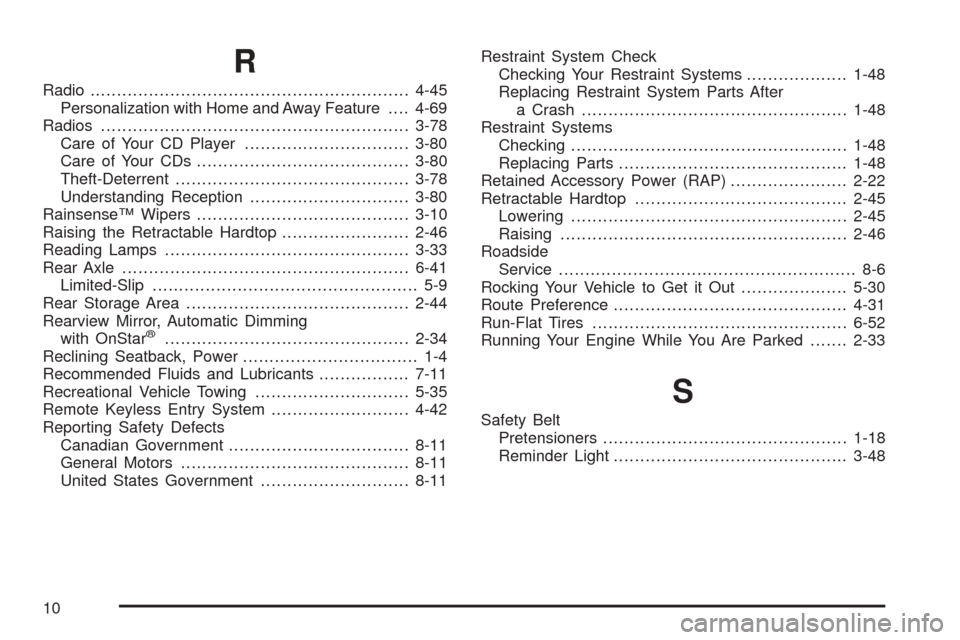
R
Radio............................................................4-45
Personalization with Home and Away Feature....4-69
Radios..........................................................3-78
Care of Your CD Player...............................3-80
Care of Your CDs........................................3-80
Theft-Deterrent............................................3-78
Understanding Reception..............................3-80
Rainsense™ Wipers........................................3-10
Raising the Retractable Hardtop........................2-46
Reading Lamps..............................................3-33
Rear Axle......................................................6-41
Limited-Slip.................................................. 5-9
Rear Storage Area..........................................2-44
Rearview Mirror, Automatic Dimming
with OnStar
®..............................................2-34
Reclining Seatback, Power................................. 1-4
Recommended Fluids and Lubricants.................7-11
Recreational Vehicle Towing.............................5-35
Remote Keyless Entry System..........................4-42
Reporting Safety Defects
Canadian Government..................................8-11
General Motors...........................................8-11
United States Government............................8-11Restraint System Check
Checking Your Restraint Systems...................1-48
Replacing Restraint System Parts After
a Crash..................................................1-48
Restraint Systems
Checking....................................................1-48
Replacing Parts...........................................1-48
Retained Accessory Power (RAP)......................2-22
Retractable Hardtop........................................2-45
Lowering....................................................2-45
Raising......................................................2-46
Roadside
Service........................................................ 8-6
Rocking Your Vehicle to Get it Out....................5-30
Route Preference............................................4-31
Run-Flat Tires................................................6-52
Running Your Engine While You Are Parked.......2-33
S
Safety Belt
Pretensioners..............................................1-18
Reminder Light............................................3-48
10